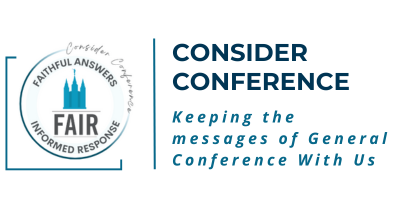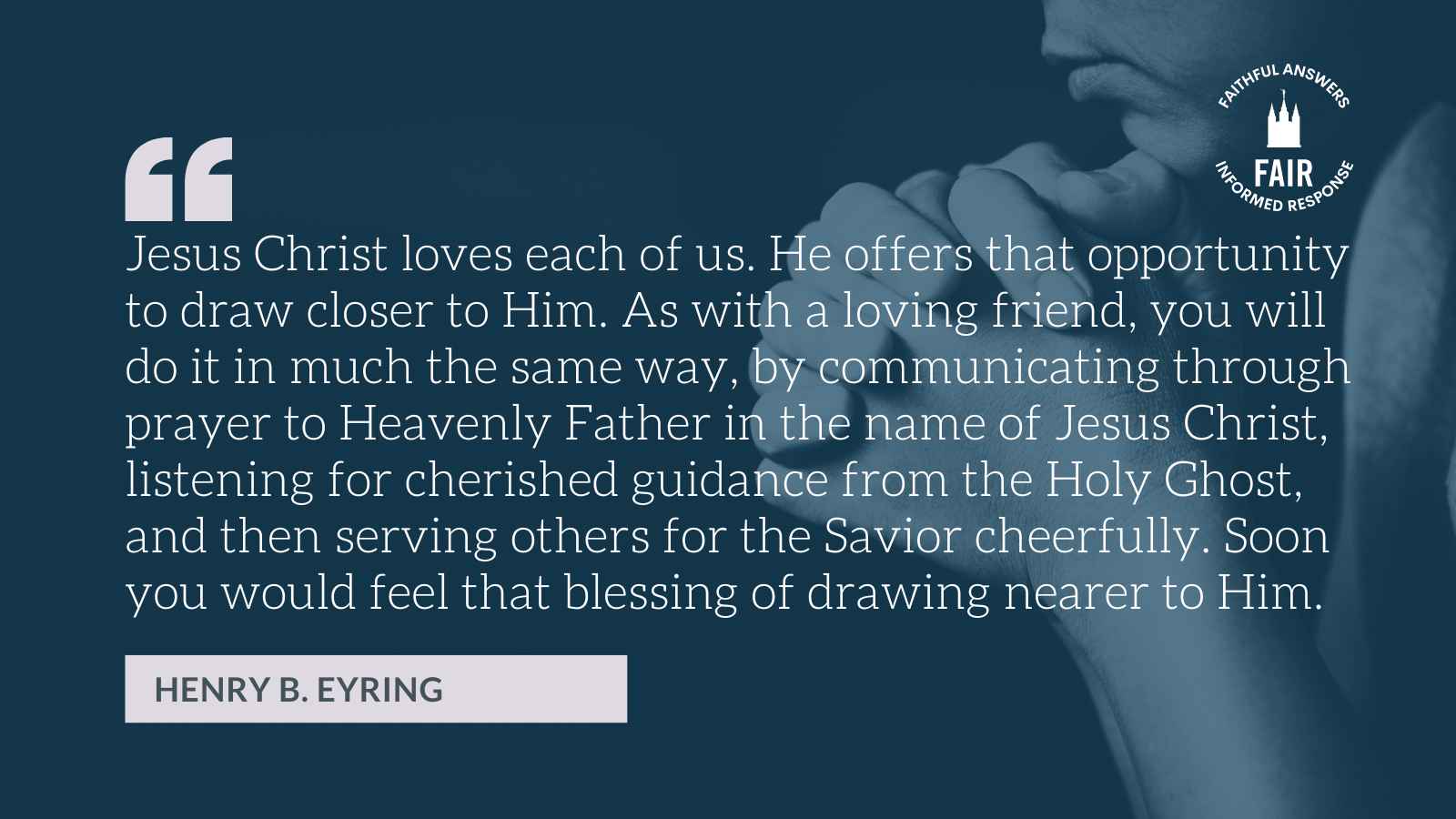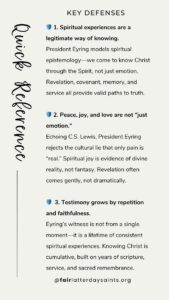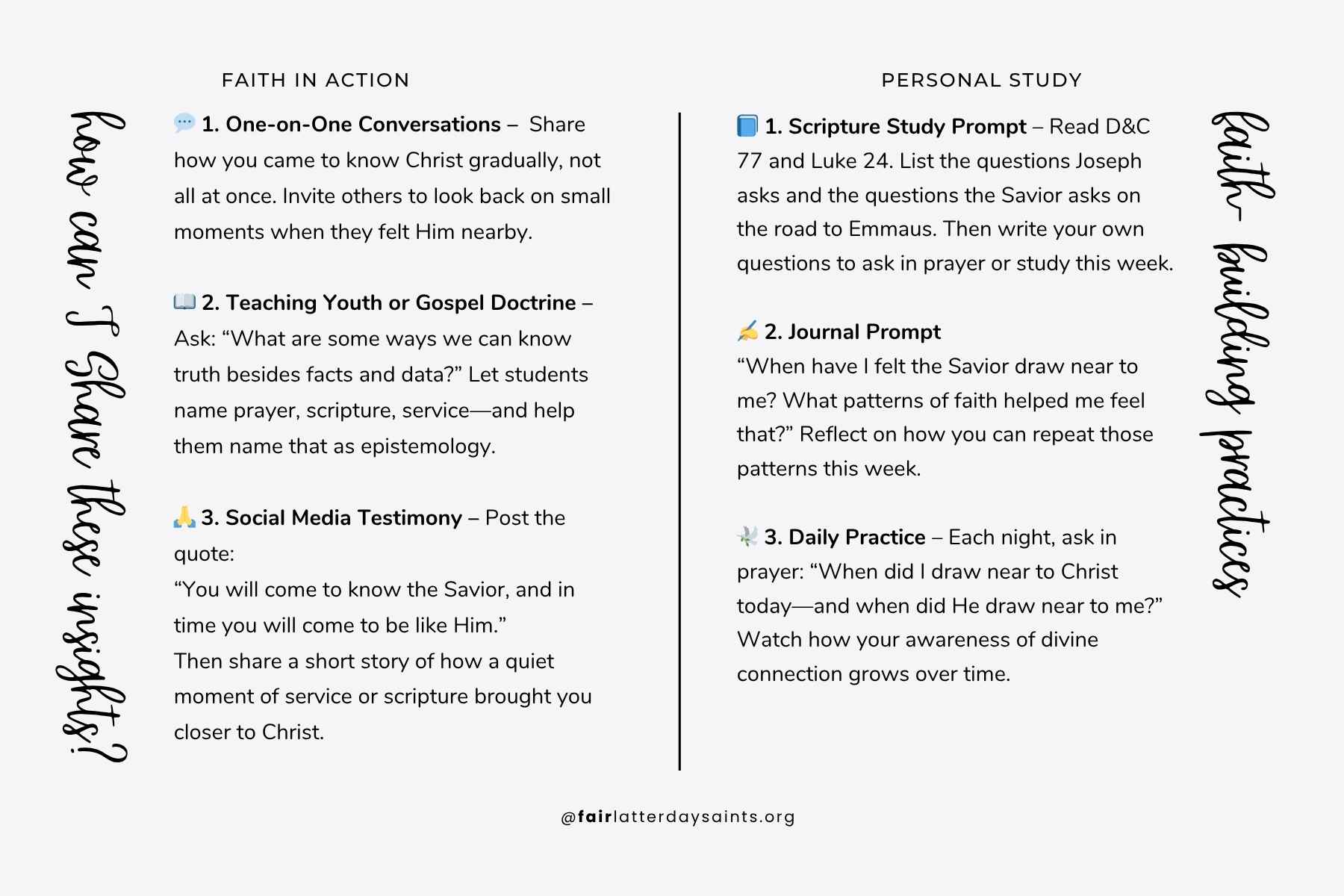
Spiritual Epistemology in President Eyring’s “Draw Near unto Me”
Have you ever wondered how you can really know the Savior—not just believe in Him, but know Him?
In his deeply personal testimony Draw Near unto Me, President Henry B. Eyring of the First Presidency invites us to consider the many ways we come to know Jesus Christ—not just through grand revelations, but through small, faithful acts: prayer, covenant, scripture, service, and spiritual memory.
In a world that often dismisses spiritual experiences as “just feelings,” President Eyring offers something both bold and deeply grounded: a lived, layered witness of Christ. He shows that faith is not blind, and that knowledge of divine things is possible—because Jesus Christ draws near to those who draw near to Him.
As we study Doctrine and Covenants 77–78, we see the Prophet Joseph Smith asking questions about the book of Revelation—and receiving divine answers. President Eyring’s talk echoes that process in a modern, personal way: both remind us that God honors the seeker.

Apologetic Issues: Knowing Truth & Trusting Spiritual Experience
Criticism: If spiritual experiences are subjective and emotional, how can they be considered real evidence of truth?
Response: This concern is common in a culture that privileges the empirical and dismisses the spiritual. But President Eyring challenges that view—not by abstract argument, but by example. He shows that spiritual knowledge is cumulative, experiential, and confirmed through multiple witnesses over time.
Spiritual truths are not “less real”—they are part of a broader epistemology that includes reason, memory, service, and revelation. We do not need to apologize for spiritual witness. We can anchor it.
Common Fallacy: False Dichotomy—the mistaken idea that truth must be either emotional and unreliable or empirical and objective.
This criticism sets up a false choice by saying something is either emotional and not real, or factual and trustworthy. But spiritual truths—like knowing God is near—can be both felt and real. They don’t have to fit into just one box.
Correction: In reality, truth can be known through many means—logic, experience, testimony, scripture, revelation. Latter-day Saint belief embraces a holistic epistemology that integrates the mind and the Spirit.
Social Issue: “It Felt Real, but It Was Just Emotion”
Misconception: “I used to feel something at church or in scripture study, but I realize now it was just emotion—not anything real.”
Response: This is exactly the distortion C.S. Lewis warned about in The Screwtape Letters. When spiritual feelings are dismissed as fantasy, while pain and fear are exalted as truth, we fall into a cultural trap that confuses reality with trauma.
Lewis writes: “The general rule which (the devils) have now pretty well established among them (humans) is that in all experiences which can make them happier or better only the physical facts are ‘Real,’ while the spiritual elements are ‘subjective.’”
(Letter 30)
President Eyring reclaims spiritual experience as valid and sacred. His witness of feeling light during the sacrament, of ‘burning hearts’ on the road to Emmaus, and of the Savior’s nearness through covenant, testifies that spiritual peace is not delusion—it is revelation.
Common Fallacy: Reductionism – The error of oversimplifying something complex by explaining it only in terms of one of its parts—ignoring its full meaning or depth.
In this case, this error reduces spiritual experiences to “just emotions,” as if that’s all they are. But real experiences with God often include feelings—and meaning, memory, action, and change. There’s more going on than just emotion.
Correction: Just as music cannot be explained by sound waves alone, spiritual experiences are more than the sum of their parts. They point to a divine source and invite us to know the Savior.

Apologetic Application: Sentiment or Truth?
Today’s critics often challenge religious conviction by questioning its epistemology—How do you know it’s true? Faith, they argue, is just an emotion. A warm feeling. A sentiment.
President Eyring answers that claim not by debate—but by demonstration.
Through quiet, layered experiences, he shows how spiritual knowledge comes through scripture, prayer, service, memory, and covenant. His testimony is not built on momentary emotion but on decades of repeated witness. When he says, “I am a witness of the Resurrection as surely as if I had been there,” he’s affirming a kind of spiritual knowing that is real, reliable, and cumulative.
C.S. Lewis described this very issue in The Screwtape Letters, where a senior devil boasts that people have been trained to believe only painful emotions are “real,” while joy, beauty, and divine peace are dismissed as illusion:
“In all experiences which can make them happier or better, only the physical facts are ‘Real’ while the spiritual elements are ‘subjective’… (the man you’re tempting), properly handled, will have no difficulty in regarding his emotion at the sight of human entrails as a revelation of Reality and his emotion at the sight of happy children or fair weather as mere sentiment.”
—Letter 30, The Screwtape Letters
Spiritual experiences are not less real—they are the very moments when we most clearly perceive divine reality.
Defending Core Beliefs
 1⃣ Spiritual knowledge ≠ wishful thinking.
1⃣ Spiritual knowledge ≠ wishful thinking.
A common criticism is that religious belief is just emotional comfort or sentimentality. But this assumes that feelings of peace, love, or spiritual insight are less real than fear, doubt, or anger. As President Eyring’s testimony shows, spiritual experiences are valid and cumulative ways of knowing.
When President Eyring testifies, “I am a witness of the Resurrection… as surely as if I had been there”, this is not blind belief—it’s a knowledge formed through decades of prayer, scripture, service, and covenant. Latter-day Saints reject the false idea that truth must be purely empirical. God speaks through the Spirit—and we can know it.
2⃣ Feelings ≠ fantasies.
Critics often reduce spiritual experiences to “just feelings.” This reflects a reductionist mindset: simplifying something sacred to a single biological cause and dismissing its spiritual depth. But scripture teaches, “Did not our heart burn within us?” (Luke 24:32). That burning is not imaginary—it’s revelatory.
As C.S. Lewis warned, our culture often treats trauma as truth and joy as illusion. But President Eyring reclaims joy, memory, and peace as sacred evidences of Christ’s reality. Knowing God isn’t irrational—it’s relational.
Practical Apologetic Use:
When someone says, “You just believe that because it makes you feel good,” reframe it:
“Spiritual feelings are part of how we recognize truth—not the whole of it, but an important part. Just like love, trust, or beauty, some of the most important truths in life are known through experience, not just data.”
The gospel doesn’t ask us to shut off our minds. It asks us to bring our whole souls—mind, heart, and spirit—to the process of coming to know Christ.
Historical and Doctrinal Connections
Throughout every dispensation, God has invited His children to draw near by seeking truth, asking questions, and acting in faith. From Moses at the burning bush to Joseph Smith in the Sacred Grove, truth has been revealed not through passive observation—but through faithful inquiry, covenant, and discipleship.
President Henry B. Eyring echoes this eternal pattern in his talk Draw Near unto Me. His personal witness unfolds through prayer, scripture study, covenant keeping, and a lifetime of spiritual remembrance. It is a deeply Latter-day Saint model of how we come to know truth.
This week’s Come, Follow Me lesson from Doctrine and Covenants 77–78 beautifully parallels that model:
 D&C 77: Asking Questions to Receive Revelation
D&C 77: Asking Questions to Receive Revelation
Joseph Smith approaches the Lord with a series of direct questions about the book of Revelation—and receives inspired answers.
This teaches that asking sincere, faithful questions is an essential part of knowing divine truth.
President Eyring does the same: he searches the scriptures, prays to feel the Savior’s nearness, and reflects on past witness to strengthen present faith. This shows how the pattern of prophetic inquiry is also the pattern of personal discipleship.
This continuity—from ancient Israel to early Restoration Saints to modern-day Apostles — strengthens our confidence that God still reveals truth, still honors covenants, and still draws near when we ask, seek, and knock (D&C 88:63).
Living Apologetics: How to Apply This Today
 How can we show that knowing Christ is not sentimental—but spiritual, cumulative, and real?
How can we show that knowing Christ is not sentimental—but spiritual, cumulative, and real?
President Eyring teaches that we come to know the Savior through repeated acts of faith: scripture study, prayer, covenant keeping, and service. Apologetically, this counters the claim that faith is naïve emotion or social conditioning. It reveals faith as a discipline of divine familiarity—a real relationship built over time.
Principle in Practice: Two Ways to Apply Apologetic Principles
1⃣ Reframe “It was just emotion” with spiritual epistemology
When someone says, “I used to feel something at church, but I realize now it was just emotion,” respond gently:
→ “What if those feelings were actually telling the truth? President Eyring teaches that peace, love, and joy are part of how the Spirit helps us recognize what’s real.”
→ Then share: “You will come to know the Savior, and in time you will come to be like Him.”
2⃣ Honor sincere seekers by pointing to Joseph Smith’s model
If someone wonders whether it’s OK to question and seek truth in spiritual matters, say:
→ “Doctrine and Covenants 77 shows that even prophets ask questions—and God answers. Faith isn’t afraid of questions. It grows from them.”
→ Invite them to explore their questions through prayer, scripture, and personal reflection.
Top Apologetic Facts
- Revelation comes through faithful questioning. (Historical Context)
In Doctrine and Covenants 77, Joseph Smith receives answers from God by asking direct, sincere questions. This confirms that the Restoration is not built on blind belief but on prophetic inquiry, showing that faithful discipleship welcomes truth-seeking. - Spiritual experiences are a valid source of knowledge. (Doctrinal Insight)
President Eyring’s talk demonstrates spiritual epistemology—we can come to know the Savior through prayer, memory, covenant, and service. The Holy Ghost is a teacher, not a vague feeling (see Moroni 10:5; D&C 88:63). - Testimony grows through lived discipleship. (Practical Application)
Eyring’s witness isn’t dramatic or sudden—it’s the fruit of a lifetime of faithful patterns. This models a defensible, reproducible path of gaining knowledge: small acts of obedience that build cumulative certainty.
Conclusion: Knowing the Savior—Not Just Believing in Him
President Henry B. Eyring’s quiet, confident witness in Draw Near unto Me offers more than inspiration—it offers a roadmap. In a world that questions whether spiritual experiences are real, he gently testifies that they are not just real—they are how we come to know Jesus Christ.
This is not abstract theology. It’s personal and practical. Through scripture, service, prayer, covenant, and memory, we draw near to Christ—and He draws near to us. As we walk that path repeatedly, our hearts begin to burn, and our understanding deepens.
The same pattern appears in Doctrine and Covenants 77–78. Whether it’s Joseph asking questions and receiving revelation, or the Lord promising to “lead [us] along,” the message is clear: Discipleship is not passive. Revelation is not rare. And closeness with Christ is not reserved for the perfect.
“Draw near unto me and I will draw near unto you.” (D&C 88:63)
Which moments in your life have become evidence that God draws near to you?

The Consider Conference series by FAIR offers an in-depth look at recent General Conference talks to help members of the Church of Jesus Christ of Latter-day Saints navigate common questions, misunderstandings, and criticisms. Each post provides doctrinal insights, historical context, and practical ways to apply gospel principles in everyday conversations. Through this series, we hope to equip readers with faith-promoting resources that encourage thoughtful reflection, respectful dialogue, and a stronger foundation in gospel truths, fostering both personal conviction and meaningful discussions with others.
The post Drawing Near: How We Come to Know Christ appeared first on FAIR.
Continue reading at the original source →




